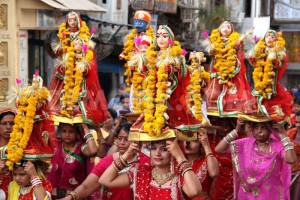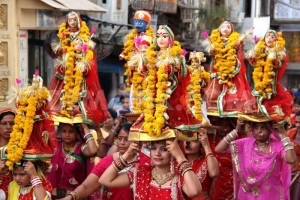Gangaur is the colourful and the one of the most important festivals of people of Rajasthan. This festival is dedicated to Lord Siva and his wife Parvati. “Gan” resembles Lord Shiva and “Gaur” resembles Goddess Gauri. he festival commences on the first day of hindu calender month “Chaitra“. Newly wed girls fast for 18 days which is considered the full process of the puja and have one meal at a day. Many unmarrie
Gangaur is consider to be the best time of year to select a life partner. Men and women from different places get the opportunity to meet and interact. Many pick there partners and marry. Gangaur is celebrated all over Rajasthan at the end of winter and the onset of spring most probably near holi. The Gangaur grand celebrations take place in Jaipur, Udaipur, Jodhpur, Jaisalmer, Bikaner, and Nathdwara. In Udaipur, Gangaur coincides with the Mewar Festival.
On the final day of this festival, a procession with the image of Gauri, commences from the Zanani-Deodhi of the city Palace. This procession then pass through Tripolia Bazaar, Chhoti Chaupar, Gangauri Bazaar, Chaugan stadium and finally converge near the Talkatora.
Though celebrated throughout Rajasthan, the festival is a treat to watch in Jaipur and Udaipur. The festival is celebrated with great pomp and show in Bikaner, Jodhpur and Jaisalmer also. The procession to Pichola Lake is the spotlight of the Gangaur festival in Udaipur whereas the city of Jaipur wears a festive look all the time. The shops, houses and streets are beautifully decorated during this festival. The fair of ‘lotias’ is a distinctive feature of the Gangaur celebrations in Jodhpur. In Nathdwara, the procession of Gangaur lasts 7 days. The Girasia tribe, who live in Sirohi-Mount Abu region, celebrate Gangaur as a prolongation of festivities from Holi to Akshaya Tritiya – lasting for more than a month. In Banswara, the procession is taken out from the Zenana Deorhi to Singhvashi Chowk, both are areas within the palace compound. So, in this way its celebrated differently in various parts of Rajasthan.
Holding a special meaning to the Rajasthanis, this festivity is celebrated in honour of Gauri, the goddess of abundance. Young girls embellished in their best clothes pray for a spouse of their choice. The married ladies pray for the welfare and long-life of their husbands. Singing and dancing is the main part of the festival. Girls worship the goddess right through the fortnight.
The above mentioned are just a few glimpses of the festivities which take place in the magnificent state of Rajasthan. Rajasthan Tourism ensures merriment and care for all the tourists who participate in the fairs and festivals. There are plenty of more festivals that you shall discover when you plan your own Rajasthan Tours.
